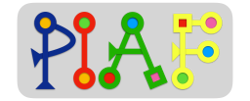On this page you will find some of the teaching scenarios created as part of the Erasmus+ PIAF project. Each teaching scenario is available for download as a pdf file that contains all necessary materials and instructions, both for teachers and students.
The development of these scenarios was done through a participatory design process. Teachers participated in the creation and/or the test of these scenarios. They also suggested changes to make the scenarios more in line with the reality in practice. For our part, we accompanied the teachers in the creation of these scenarios and modified them according to the comments received.
To find additional scenarios and in other languages, please check out our corresponding French and on German webpages.
These documents are suggestions that you can (and should) of course adapt to the context of your class yourself. So please feel free to send us your comments and feedback.
Be Quick!
Learners are presented to different algorithms used by computers to sort numbers. At first, learners are presented with the challenges of sorting arrays of numbers and strings (e.g. names). Then they learn the algorithms designed for computers for sorting arrays of numbers. The taught sorting algorithms are Radix, Bubble and Selection. Students learn these algorithms first by a topic introduction by the teacher and then by hands-on activities either on paper or through physical exercises.
Find your way!
Learners perform different types of decoding activities where they acquire an understanding of the specific order of actions needed for decoding. Formal and informal language representations are used for decoding messages into a common, understandable visualization (i.e. Latin characters and numbers on base 10).
From Wheels to Robots
Students will be able to program the basic functions for a Lego robot car to move, steer, stop and use color sensors. Firstly, students are presented with the challenge of controlling the Lego robot by programming. Secondly, students will learn how to program the Lego robot with the color sensors. In the end, students will define, predict, create, and test action sequences for the robot car while completing certain activities.
Guide me in Codes
Learners complete a series of exercises on a block programming interface involving a character and mazes. The exercises, of increasing complexity and difficulty, teach the learners about basic programming actions, creation of programming algorithms, and debugging existing code.
Logic Gates
Students learn about Boolean Logic and Logic gates that are used in digital circuits. At first, they are given simple goals such as making a simple logic “if” statement by relating two images and ideating an outcome. Later on, using visual representations of logic gates and basic circuits where students need to indicate the correct input, output, and/or logic gate. Simple and complex goals consist of simple and complex circuits using multiple logic gates. For reaching those goals, students must identify, understand, and execute the correct sequence of actions.
Make it draw!
Learners learn about patterns and how to identify elements of patterns of figures composed of geometrical shapes as well as numerical patterns.
We are music!
Learners use the block-based visual programming language App Inventor to create music apps. They identify the input components of simple and complex action sequences required to create a musical sounds. They ensure that their music apps produce the expected musical output and make any necessary corrections in terms of the coding of the app or the parameters of the app components.
